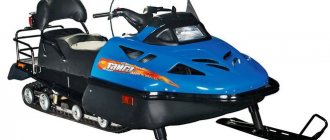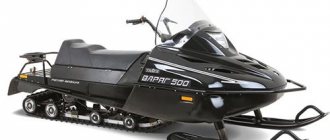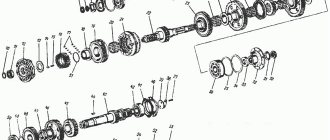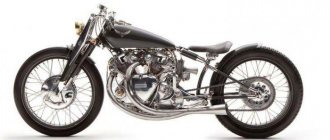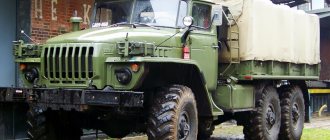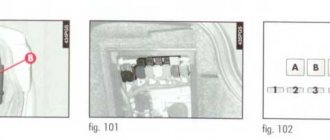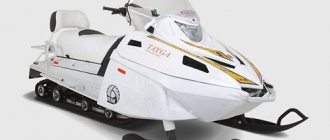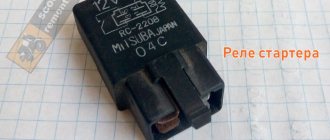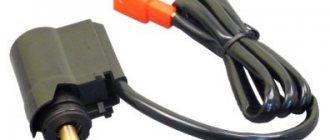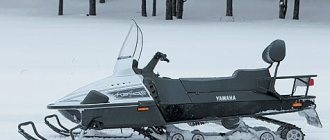Snowmobile front suspension - its types and schematic representation
The shock absorption system on a snowmobile consists of rear and front suspension. I would like to focus my attention specifically on the front suspension, since there is not so much information regarding this unit. What are the challenges facing the nose suspension of a snowmobile? - This is, first of all, ensuring the smoothest possible ride so that the pilot does not feel any vibrations from moving over various uneven surfaces. We’ve sorted out the main function, now it’s worth considering the types of front suspensions.
The role of the rear suspension in the movement of a snowmobile
Most often, the rear suspension is equipped with a linear force element, which is located outside the vehicle's track. The linear force element mounts are located on the frame and on the corner arm of the vehicle. Also, sliding rails are connected to the corner lever and supporting rollers are attached to it. When folding the sliding rails using an angular lever, the linear force element is advanced, after which the suspension moves smoothly in its range. The rear suspension system of a snowmobile works on this principle.
Telescopic suspension
Perhaps this is one of the most common and simplest types of suspension based on the principle of operation. Most often, this suspension is used on snowmobiles of the “utilitarian” class. The design of the telescopic fork consists of a spring and shock absorber, which are located directly in the strut. Thus, the telescopic stand is able to smooth out shock-type loads. It is worth noting that the stroke of this type of suspension is limited according to the stroke of the shock absorber itself. As a rule, snowmobiles with such suspension have incredible maneuverability in dense forest conditions, since the ski base is small.
Also, one of the simplest and most common suspensions is the spring system. This engineering solution was used on the legendary domestic car "Buran". This model has one ski track, as a result of which the equipment does not have the necessary maneuverability. It is generally extremely difficult to enter the required turn at speed. But in general. The suspension performance itself is quite acceptable.
Why does the rear suspension need modification or replacement?
Whether a snowmobile needs tuning, in particular changes to the rear suspension parameters, is determined by the purpose for which the vehicle will be used.
Are there two types of snowmobile suspensions? connected and unrelated. A connected suspension has two main advantages:
- she shares the toughness;
- controls weight transfer if the vehicle picks up speed.
Often this type of rear suspension is installed in snowmobiles that will be used for sporting purposes or for transporting cargo. This is necessary in order to cope well with sharp turns, strong shaking and frequent redistribution of weight.
Unconnected pendants have their own characteristics. Their front and rear elements are independent. Therefore, if the front part deviates, the rear either deviates only a little or remains in place.
Unlinked harnesses are best attached to snowmobiles that are used in deep snow or have long tracks. They are more capable of increasing traction and also distribute weight well. Also, improving the performance of the suspension may be necessary if the snowmobile engine has been tuned. After all, in order for a vehicle to cope with new loads, a comprehensive modification is necessary, and the suspension in this case? not an exception.
First of all, suspension tuning includes replacing shock absorbers. The main types of shock absorbers for vehicle suspensions:
- simple shock absorber;
- telescopic shock absorber;
- shock absorber for enduro;
- shock absorber for crosses.
In case the main purpose of the snowmobile is? normal riding, then enduro shock absorbers are needed. They are applicable in production 440 Pro vehicles, but the price of such shock absorbers is also considerable. Shock absorbers for tuning sport snowmobiles are often equipped with additional volume gas chambers that allow them to be tuned for specific applications.
Also, the rear suspension often needs adjustment. The choice of adjustment level depends on what kind of physical load is planned for this vehicle, what the weight of the driver and passengers is, how the driver is used to driving the vehicle, what his personal preferences are, the speed mode and the condition of the roads. Each part of the rear suspension is responsible for specific functions. Therefore, in order to know what you will achieve by adjusting the suspension, you need to decide which part needs to be adjusted.
- The job of the rear springs is to ensure smooth movement.
- The purpose of the extension cord? provide reverse movement, taking into account the loads and condition of the snow paths.
- The shackle is adjusted taking into account the condition of the snow path and what the loads will be.
- How comfortable it will be to drive the snowmobile depends on the adjustment of the central spring.
- The tape limiter controls the redistribution of weight.
- Thanks to the shock absorbers, the snowmobile is easy to control and comfortable to ride and sit on.
DSA suspension
This suspension is characterized as the first long-travel system that was used in the construction of snowmobiles. To be more precise, it was installed on the F2000 and S2000 chassis. The shock absorbers and springs are located between the levers (arranged in parallel) and the chassis. The inclination of the springs and shock absorbers towards the central part of the snowmobile is maintained. Due to this, the travel of the suspension itself is greater than that of the shock absorber. The shock-absorbing system consists of a snow frame and a trailing arm to which two transverse arms are connected. Levers located transversely must have the same length. There are snowmobile models on which the length of the levers can be adjusted. This adjustment is relevant when it is necessary to overcome an icy section of the route. There is no point in adjusting the length of the levers when moving in deep snow. The disadvantage of this suspension is the lack of controllability of the snowmobile due to the horizontal movement of the skis.
ADSA suspension
In essence, this is the same DSA type suspension, only in this case the length of the wishbones is different. There are snowmobile models where, due to the use of ADSA suspension, it is possible to adjust the camber angle. This type of suspension found its way onto the S2000 chassis. The ZX chassis already featured the next generation of suspension, called the ADSA ZX. It is characterized by the ability to adjust the camber, and the movement of the transversely located levers has also been significantly changed. Owners of snowmobiles using this suspension system unanimously note a high level of controllability compared to DSA.
RAS SUSPENSION
This type of suspension found its application on the REV chassis. The design of this suspension is based on double A-arms. The principle of operation of this suspension is as follows - the main part of the shock load falls directly on the spring and shock absorber and only a small part on the chassis itself. Typically, a snowmobile with a REV chassis has a pyramidal frame shape. Due to this, the design of the snowmobile is incredibly durable, capable of withstanding heavy loads and the movement of the snowmobile on the most extreme trails.
Video
Do-it-yourself snowmobile from a walk-behind tractor: reasons for choice and selection criteria
A walk-behind tractor is a worthy technique for transformation, which is in the arsenal of almost every resident of our country. In the list of homemade devices that can be adapted from it, the snowmobile occupies one of the first places, competing with the caracat and the all-terrain vehicle. This is due to the fact that in winter, when a snowmobile is needed, the farm does not need the standard tasks of plowing, hilling or mowing the grass. Therefore, it makes sense to remove the engine in the winter and make a snowmobile based on it, and in the summer to return it to the walk-behind tractor and operate it in the standard way. Not every modification of a walk-behind tractor is suitable for a snowmobile. It is best to use for this purpose those that have:
- rear towing device;
- possibility of manual control;
- medium-power motor, cooled by air.
The Neva walk-behind tractors, which are available in eight models, are considered ideal for a homemade snowmobile from a walk-behind tractor. All of them represent a group of tillage machines with average traction potential (6-9 hp). Despite their low cost, the motor systems are assembled and tested in Japan, which makes them extremely durable.
Taking all these points into account, such walk-behind tractors make snowmobiles with good power. This means that it will be able to carry not only the driver, but also at least one passenger.
Shock absorbers for snowmobiles
Share with your friends
Applicability
Yamaha
- RS Venture TF
- VK540
- VK10D
- VK PROFESSIONAL II
Russian mechanics
- Taiga Attack 551 II
- Taiga Varyag 500
- Taiga Varyag 550
- Taiga Varyag 550V
- Taiga Bars 850
- TAYGA PATRUL SWT
- Army
- TIKSY 250
- TIKSY 250 lux
The principle of operation of the shock absorber on the Varyag 550 snowmobile
When preparing your new snowmobile for use, do the following:
check the integrity of the packaging and the integrity of the seals;
open the packaging, remove the operating documentation, check its correctness. Using the packing list, check the completeness of the parts and assembly units removed from the snowmobile and their safety, as well as the presence and completeness of spare parts (see the “Completeness” subsection of the snowmobile passport);
unpack the parts and assembly units removed from the snowmobile; Check for mechanical damage to the surface of the hood, frame, seat, glass, and if necessary, repair damage to the body coating.
remove the external preservation grease, reinstall the parts and assembly units removed when packing the snowmobile:
Unscrew the nut securing the bracket at the rear of the snowmobile to the block of the bottom of the box. Unscrew the bracket fastening bolt and remove the bracket from the snowmobile hitch hook;
unscrew the nuts securing the brackets of the front part of the snowmobile, remove the bolts and brackets (for snowmobiles TAIGA Lux 550 II, TAIGA Attack 551 II);
straighten (for example, using a pipe) the studs of the snowmobile telescopic racks to the bottom of the box, avoiding damage to the threads and without applying shock loads. Unscrew the nuts securing the rod brackets to the bottom of the box. Then remove the nuts on the link studs and remove the links from the telescopic stands (by lifting or tilting the snowmobile on its side). Remove the self-locking M10 nuts with washers from the rods of the hydropneumatic shock absorbers (do not remove the locking rings), install two plastic bushings in the ear of each shock absorber, then insert the shock absorbers into the telescopic struts and secure them with self-locking M10 nuts with washers, the nuts must be tightened with a torque of 2, 7…3.0 kgf m (for snowmobiles TAIGA Classic 500, TAIGA Varyag 550, TAIGA Bars 850);
Frame and body
Before work, it is recommended to draw up a drawing of the frame. The structure is welded from a square pipe 25 x 25 mm with a wall thickness of 2 mm. For a payload of over 150 kg, the section size is increased to 30 x 25 mm. The loading area and body elements are covered with plywood. The seats are selected with a hydrophobic coating.
In the center of the fracture frame there is a hinge that allows rotation around a vertical axis. The maximum rotation angle is limited by welding metal plates. The front half is used for steering, and the engine is placed on the rear half frame.
The solid frame is welded in the form of a rectangle, inside of which axles and tracks are located. The engine is placed in front on a special platform, rigidly welded to the rest of the frame. In both cases, the motor is installed in the transverse direction (the shaft faces the end).
Design and functionality
The Varyag 550 has high traction characteristics, thanks to which the snowmobile copes well on almost any surface and with various loads. This vehicle is suitable for fishermen and hunters, as its high cross-country ability allows it to reach hard-to-reach places.
The Taiga Varyag 550 snowmobile is equipped with a power plant of its own production - a two-stroke engine of the RMZ-550 brand. The block contains two cylinders, the total volume of which is 0.553 liters.
As standard, the engine is equipped with one Mikuni carburetor. The rated output power of the RMZ-550 reaches 36.78 kilowatts, which translates to 50 horsepower.
Air type cooling system. Starting is carried out using an electric starter, but the engine can also be started manually. The programmable ignition system of the DUCATI CDI model is used.
The installed engine allows you to develop a rated power of 36.78 kilowatts, which translates to 50 horsepower. The rear suspension of the snowmobile was specially designed to transport fairly heavy loads.
Is it necessary to register such changes with Gostekhnadzor?
Probably everyone already knows that when purchasing a snowmobile, it must be registered. You also need to have a category A license to drive such a vehicle. Using a snowmobile without a license or while intoxicated is strictly punishable by law. However, are there rules regarding the registration of small changes to the design of a snowmobile, such as rear suspension changes?
The law establishes the rule that owners of any vehicle must present it for technical inspection from time to time. Snowmobile? not an exception. The interval at which this needs to be done is determined depending on the terrain and type of vehicle. If a tracked vehicle is designed for eight or more seats for passengers, then it must be presented for technical inspection every six months. If this is an ordinary snowmobile, then it needs to be inspected every year. When undergoing regular technical inspection, there is no need for additional registration of minor changes in the design. Main ? ensure safe movement on a snowmobile.
How to adjust the carburetor
The manufacturer and experts recommend adjusting the carburetors after the snowmobile has been run-in (300 kilometers). Here the owner has a choice - send it to a service center or make the adjustment himself. By following our instructions, even a beginner can handle the setup.
- We check the opening of the carburetor throttles for synchronism; to do this, remove the intake noise muffler, take a mirror measuring 140 by 40 millimeters and look into the carburetor diffusers while smoothly squeezing the gas lever. If the throttles do not move synchronously, you should use the technical documentation for setting up for adjustment.
- We look to see if there is any play on the sheath of the fuel corrector drive cables “must be in the closed position.”
- Let's look at the position of the carburetor metering needle locks. According to the manufacturer's recommendations: the needle locks should be in the middle third groove.
- We check the carburetor dosage details: GTZ 230 (main fuel jet);
- ZHKH 55 (idle jet). We recommend replacing the idle jets with ZHKh 40, you can take them from the VM-34-560 carburetor.
- We clean the spark plugs from carbon deposits and set the gap to 0.7-0.8 millimeters.
How much does the base model and its modifications cost?
The Taiga Varyag 550 snowmobile in its basic configuration belongs to the middle price segment. Cost - from 349,000 rubles. This snowmobile is the most practical and powerful in its class. A used car is sold on Avito for 250,000-300,000 Russian rubles. In this case, the price fluctuates depending on the year of production of the snowmobile and the technical condition of the vehicle.
In addition to the main model, there are also modifications - Taiga Varyag 550 V and Taiga Varyag 550 Limited. Their price exceeds the cost of a basic snowmobile:
- Taiga Varyag 550 V. Features extended equipment. A power plant of the RMZ-550 model is installed, equipped with two Mikuni model carburetors, air cooling and a two-speed gearbox. It also uses the DUCATI CDI programmable ignition system, which ensures optimal operation of the power unit regardless of operating modes. Price: from 389,000 rub.
- Taiga Varyag 550 Limited. Key features of this configuration are two carburetors on Mikuni models, allowing the engine to develop a rated power of 40.45 kilowatts (55 horsepower). Instead of a conventional gearbox, the manufacturer equipped the snowmobile with a variator transmission (CVT). Otherwise, the Limited version is completely identical to the previous one; it uses the same programmable DUCATI CDI ignition system and air cooling. Price: from 394,000 rub.
In terms of maintenance, the Taiga Varyag is very simple and unpretentious; all parts are sold in auto parts stores for motorcycles. Here are approximate prices for some parts for this model (in rubles):
